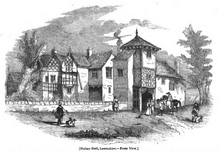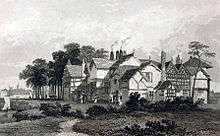Hulme Hall, Hulme
Hulme Hall was a manor house adjacent to the River Irwell in Hulme, Manchester, England. A structure of this name existed from at least the time of Henry II (1133–1189) until its demolition around 1840 during development related to the Bridgewater Canal. Owners included the Prestwich and the Mosley baronets prior to the property being bought from George Lloyd in 1764 by Francis Egerton, 3rd Duke of Bridgewater.

Description
The hall was a manor house. It was a half-timbered building comprising two stories and built round a quadrangle, situated on a rise of red sandstone that overlooked the River Irwell in the township of Hulme, Manchester. It was well known for its gardens in the 18th century but was demolished around 1840 as part of the development of the Bridgewater Canal. It had been noted to be in poor condition in 1807 and by that time was leased to various poor tenants. Some 16th-century carved oak panels were removed to Worsley Old Hall around 1833.[1][2]
Ownership

The building was owned by John de Hulme during the reign of Henry II[1] and by the de Rossindale family by the time of Edward I.[3] During the reign of Henry IV, it was owned by a branch of the family of Prestwich baronets and remained with them for centuries, with a five-year interlude when it was in the possession of Henry de Byrom. Sir Thomas Prestwich sold it to Sir Edward Mosley, 2nd Baronet, in 1660–61. Mosley died without a direct heir at the age of 27 in 1665 and there then followed much litigation regarding his estate, made more complex by various subsequent deaths.[1][4] In 1695, ownership passed to John Bland, a member of the Bland baronets and Member of Parliament for Lancashire between 1713 and 1727. Bland had married Mosley's sole surviving heir, Anne.[1][4][5][lower-alpha 1] According to Edward Baines, around this time the hall was "among the most stately residences in the parish of Manchester".[6]
George Lloyd, a Fellow of the Royal Society, bought the hall in 1751.[1][7][8] In 1764 the property passed into ownership of the Francis Egerton, 3rd Duke of Bridgewater, who had to pay a large amount of money to acquire it so that he could continue construction of his eponymous canal.[9][10]
A hidden hoard of treasure was reputed to exist at the hall, although it was never discovered. Supposedly, this was the property of the mother of Thomas Prestwich, whose urgings of her son to advance money to Charles I probably contributed to his financial problems.[11]
Depictions
The hall was central to Sir John Chiverton, a romantic novel co-written by William Harrison Ainsworth, and among those who produced illustrations of it was Charles Allen Duval.[12]
References
Notes
- Anne Bland was the founder of St Ann's Church, Manchester.
Citations
- Baines, Edward (1836). History of the County Palatine and Duchy of Lancaster. Fisher. p. 352.
- Farrer, William; Brownbill, J., eds. (1911). "Townships: Hulme". A History of the County of Lancaster: Volume 4. pp. 335–338. Retrieved 31 May 2015 – via British History Online.
- "Old English Timber Houses". The Penny Magazine. XIII (766). 9 March 1843. p. 90.
- Harland, John, ed. (1862). Mamecestre: Being Chapters from the Early Recorded History of the Barony, the Lordship of Manor, the Vill, Borough, Or Town of Manchester. Remains, historical & literary, connected with the Palatine counties of Lancaster and Chester. 3. Chetham Society. pp. 526–527.
- Hayton, D.; Cruickshanks, E.; Handley, S., eds. (2002). "BLAND, John (1691–1743), of Hulme Hall, Lancs. and Kippax Park, Yorks". The History of Parliament: the House of Commons 1690–1715. History of Parliament Online. Retrieved 31 May 2015.
- Baines, Edward (1836). History of the County Palatine and Duchy of Lancaster. Fisher. p. 290.
- "Archive: Past Fellows: George Lloyd". The Royal Society. Retrieved 31 May 2015.
- Burke, John (1847). A Genealogical and Heraldic Dictionary of the Landed Gentry of Great Britain & Ireland. 1. H. Colburn. pp. 751–752.
- Malet, Hugh (1977). Bridgewater, the Canal Duke, 1736–1803. Manchester University Press. pp. 80, 98. ISBN 978-0-7190-0679-1.
- Harland, John; Wilkinson, Thomas Turner (1873). Lancashire Legends, Traditions, Pageants, Sports, &c. G. Routledge. p. 38.
- Harland, John; Wilkinson, Thomas Turner (1873). Lancashire Legends, Traditions, Pageants, Sports, &c. G. Routledge. p. 37.
- Heathcote, Charles H. (1873). "The Old Halls in the Neighbourhood of Manchester". Papers Read at the Royal Institute of British Architects: Session 1872–73. Royal Institute of British Architects. p. 64.